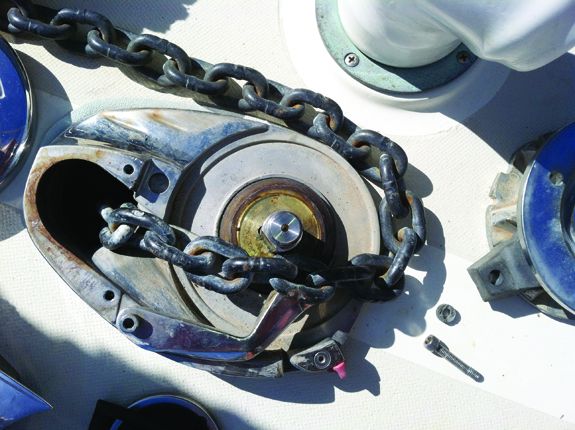
Sailing season is getting interesting here in Southwest Florida, with many local boats priming for jumps to the Caribbean-both east and west-or bound for cooler temperatures north. I spent last weekend tuning the rig aboard boatbuilder Robert Helmicks Endeavour 42, Lost Boys, and got a first-hand look at the problems reader Scott Rimmer ran into with his vertical windlass back in 2009. When Helmicks son, Kameron, went to work deploying the anchor, he soon ran into trouble; the chain was jammed in the naval pipe, kinked with hockles. Helmick started plying me with questions about anchor swivels-questions we often get.
Heres how Rimmer described his problem:
Taking the advice of a PS vertical windlass test, I installed a Lewmar V2 windlass on my Sea Sprite 34, Freedom, in 2008. I followed the installers recommendation of 100 feet of galvanized chain and 100 feet of eight-part braid, connected with a rope-to-chain splice. I have Delta 35 anchor.
I soon found that a chain hockle (a twist in the chain that jams the windlass) will terribly mangle the vertical windlass. I have just completed my second mangling and ordered replacement parts-but these parts will not save me from the next mangling. The Lewmar distributor told me to install a chain swivel, but Practical Sailor has advised against this (PS Advisor, May 2010 and Mailport, January 2011). Is an all-chain rode a dumb idea? Is there some solution?
In our experience, using stranded rode with chain on a vertical windlass is more likely to cause hockles, because of the way the line is twisted during manufacturing. This is mainly a problem for three-strand rope. Since you used plaited rode, this is probably not the main source of your woes.
One solution would be to switch to all-chain rode. There would be less twisting, but as we found last weekend (Helmick uses all 3/8-inch chain), even all-chain rodes can confound a windlass. In my view, an all-chain rode is never a bad idea. Another issue is that compact vertical windlasses are a compromise and don’t strip chain as well as a high-quality horizontal windlass. Technical Editor Ralph Naranjo put together a thoroughly researched report on the demise of the well-made windlass back in 2008. He also guided readers through a step-by-step refit of a Nilsson windlass, far superior to the chain-driven manual Simpson Lawrence windlasses that you find on many used boats.
Chain hockles can be the result of a too-shallow anchor locker or the chain having low-quality, rough galvanizing or weld splatter, which prevents the links from untangling themselves. Lewmar recommends windlass owners use stainless chain because of its smoother finish. However, we strongly recommend against using stainless anchor chain; instead, stick with good-quality galvanized, and try these troubleshooting tips:
Ideally, your anchor locker has plenty of depth under the windlass. (As our study of anchor lockers showed, however, many contemporary model sailboats literally fall short in this department.) The rode stows by gravity, and when you have a long naval pipe or the chain stacks right below the windlass, there is not enough room for gravity to do its work. The chain remains twisted as it goes into the locker and causes a problem when it comes out. You can try shortening the naval pipe, or eliminating all but the through-deck opening. Having a strong naval pipe helps too: It can take the brunt of hockle jams.
Having an accessible locker always helps. (On many boats, the naval pipe itself is open on one side, so that any jams inside the pipe itself may be easily cleared.) Often the hockles will be visible, and a crew member can prep the chain before anchoring. In my cruising days, when anchoring in some of the deeper anchorages in the Pacific, I would work belowdecks making sure the chain flowed out evenly while my wife, Theresa, deployed the anchor. It was a hassle, but better than having to reset an anchor in 60 feet of water.
I would also recommend pulling all of your anchor rode out of your chain locker at least once a season, laying it out straight or in very long bights on the deck or the dock, and then feeding it back into the anchor locker in good order. This should help prevent chain hockling in most circumstances.
You can also try using your diesel to take the load off the anchor rode as you retrieve the scope. When you get to a 1:1 scope, power forward to free the anchor. As the freed anchor hangs from the stem roller, the chain will spin, clearing hockles from the tackle. After long periods on the hook, wed sometimes pause off soundings (in calm conditions), deploy the anchor, let the chain untwist as the anchor dangled and then recover it. (Anyone who has lived with a coiled-handset-cord telephone is all too familiar with this routine.)
Now, should you install a swivel? This has been a topic of longstanding debate, and we are decidedly with the anti-swivel camp. Lewmar, however, recommends using anchor swivels.
Although some companies like Chicago Hardware have good reputations with their drop-forged, hot-dip galvanized swivels, swivels are notorious weak points that require monitoring. Our disdain for them-especially stainless ones- stems from frequent inconsistencies in the materials and manufacturing processes and the fact that stainless can fail without warning. But if you often anchor where your boat is turned around by current, traffic, and/or wind changes, then a galvanized swivel might help the chain untwist when hauling it in. But before making the leap to an anchor swivel, try the tips we mentioned.







































